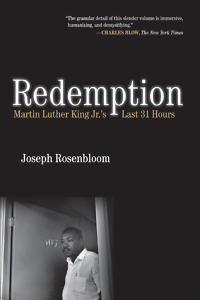A Martyr’s Redemption
Joseph Rosenbloom talks with Chapter 16 about the final days of Martin Luther King Jr.
The fiftieth anniversary of Martin Luther King’s assassination has brought renewed attention to his remarkable odyssey. King is the subject of doorstop biographies, academic studies, personal memoirs, and detailed accounts of his murder. In Redemption: Martin Luther King’s Last 31 Hours , Joseph Rosenbloom focuses on King’s final, tragic stop in Memphis, painting a striking portrait of a man, and a city, at the brink.

Rosenbloom is a former producer and investigative journalist for the PBS program Frontline, as well as an award-winning reporter who has written for The Boston Globe, The Wall Street Journal, and The Atlanta Journal-Constitution, among other publications. He answered questions via email from Chapter 16:
Chapter 16: Describe the Martin Luther King of April 3 and 4, 1968. Who was this man, and what was his understanding of the world around him?
Joseph Rosenbloom: He was in acute distress, suffering from severe insomnia and sleep deprivation, and exhausted from long, grinding days on the road. His nerves were on edge. He feared that an assassin might murder him at any moment. That dread was seizing him with fierce intensity as he returned to Memphis on the morning of April 3. Just that morning his plane to Memphis had been the target of a bomb scare at the Atlanta airport.
He was in low spirits for yet another reason. On March 28, a march that he was leading in Memphis to support a strike by the city’s sanitation workers had turned into a riot. In the aftermath, King’s reputation as a nonviolent leader was under fierce attack from politicians and the press. King was back in Memphis on April 3 to organize a second pro-strike march. This time, he vowed, the march would not spiral into violence so that he might restore his credibility as a nonviolent leader.
By April 1968, King had turned darkly pessimistic about racial and political circumstances in America. Without urgent federal action to relieve poverty, he foresaw a continuing wave of the kind of rioting that had been ravaging the inner cities of America during the mid-sixties. In reaction to the riots, a white backlash against the civil-rights movement was underway. King shuddered at the bleak political repercussions that he could imagine. In a Look magazine article that he wrote at the time, he warned that the upshot might be a “right-wing take-over” of the government and a “fascist development.”
To avoid that calamity, he was launching what he was calling the Poor People’s Campaign. It would bring thousands of poor people to Washington to demand a sweeping federal program to alleviate poverty. It was inner-city poverty, he believed, that was the root cause of the riots.
 Chapter 16: Describe the Memphis of April 3 and 4, 1968. What forces were determining the city’s politics and culture, and how did they shape King’s odyssey?
Chapter 16: Describe the Memphis of April 3 and 4, 1968. What forces were determining the city’s politics and culture, and how did they shape King’s odyssey?
Rosenbloom: Race was the defining element. Memphis was then struggling to emerge from the legacy of the Jim Crow era. Its public facilities-schools, buses, restaurants, and the like-were no longer entirely segregated. But there was still a sharp racial divide. The churches that Memphians attended, the clubs to which they belonged, the neighborhoods in which they lived-all were essentially segregated. For whites, Memphis was the City of Good Abode, a quiet, pleasant place to live and work. For blacks, it was a city that relegated them to second-class status. It was, in short, a city split into two cultures.
Whites controlled the city’s politics. Mayor Henry Loeb, who had won election in 1967 despite drawing only two percent of the African American vote, personified that dominance. Three newly elected city councilors were African American. They were outnumbered by the nine other councilors.
The mayor cited a state law prohibiting public employees from striking. By refusing to negotiate with the workers until they returned to their jobs, he prolonged the garbage workers’ strike. The racial disparity in the Department of Public Works-supervisors were virtually all white, and the workers collecting the garbage were all black-reflected much of the city’s racial profile. It was the strike, and the racial discord surrounding it, that brought King to Memphis in 1968 to pressure the mayor to negotiate with the workers.
Chapter 16: You spent the summer of 1968 as an intern at The Commercial Appeal, while Memphis was reeling from the assassination. How did this personal experience mold your interpretation of King in Memphis?
Rosenbloom: That summer I had a sense that the city was struggling to come to terms with what the assassination meant for Memphis. Many blocks of downtown Memphis were still scarred from the riot of March 28. I had a short-term rental just off Florida Street in a predominantly African-American neighborhood. It offered me a glimpse of the struggles that less fortunate Memphians were experiencing every day.
The Commercial Appeal, its offices in a large building on Union Avenue, seemed to exist apart from the social and racial tensions that still roiled the city. If any of its editors or reporters were African Americans, I did not run into them.
Those impressions that I formed during the summer of 1968 shaped how I portrayed the city’s racial landscape as tense and troubled when King was there a few months before.
Chapter 16: King had a variety of complicated relationships with women, from his wife to his staff to his mistresses. How did these women influence his outlook? How did they factor into his final days on earth?
Rosenbloom: He had a traditional view of women’s role in society. He insisted that his wife, Coretta, forego her career as a singer and devote herself instead to being a pastor’s wife and stay-at-home mother to their children. She craved a greater involvement in the civil-rights movement than he would allow. That was a source of marital tension. Another was money. He eschewed wealth and material possessions. She felt that their needs were being neglected because of a lack of money.
She must also have been at least vaguely aware that King had extramarital relations with other women. A woman with whom he was having an affair, Kentucky State Senator Georgia Davis, was with him in Memphis during the last night of his life.
His mood was pensive and melancholy during the final day of his life in Memphis. The tensions in his marriage and the complications of his involvement with other women besides Coretta likely were contributing to his gloom.
Chapter 16: King’s murder is a great tragedy, yet you title the book Redemption. Why? What was redeemed?
Rosenbloom: Redemption has a triple meaning. First, it refers to King’s return to Memphis in April 1968 to salvage, or redeem, his reputation as a nonviolent leader. Second, it refers to his belief in a federal promise that none of its citizens lived in poverty. King was calling on the government to redeem the promise. Third, it relates to Christian theology, which holds that Jesus sacrificed himself to save or redeem all humanity of its sins. King borrowed that Biblical concept and applied it to his own life. He believed that his own sacrifice, even to the point of death, in pursuit of racial and economic justice would have redemptive virtue for him in the Christian sense.

Aram Goudsouzian chairs the history department at the University of Memphis. His most recent book is Down to the Crossroads: Civil Rights, Black Power, and the Meredith March Against Fear.





